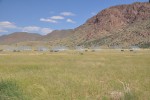Over the past 20 years scientists have learned much about how individual ecosystems are likely to respond to climate change, but extending this knowledge to regional, continental and global scales has been a far greater challenge. At these larger geographical scales, both the environment and the attributes of ecosystems vary greatly. For example, in the central United States, there are strong temperature and rainfall gradients from Texas to North Dakota and from the dry plains of Colorado to eastern Kansas. The types of grasslands differ as well, from short grasslands in the west to tall grasslands in the east. In order to better forecast how entire regions will respond to expected climatic changes, we need to understand why ecosystems differ in their sensitivity to changes in climate.
The Extreme Drought in Grasslands Experiment (EDGE) was established in 2012 to address two questions of fundamental importance for advancing our knowledge of how ecosystems will respond to climate change at large geographical scales:
1) How do grassland ecosystems differ in their sensitivity to a multi-year extreme drought and what determines their differential sensitivity?
2) How important are the attributes of ecosystems per se vs. the environmental context in which climate is changing in determining ecological responses to drought at regional scales?
EDGE is a geographically distributed field experiment with six sites in North America (in New Mexico, Colorado, Wyoming and Kansas) at the Sevilleta, Shortgrass Steppe, and Konza Prairie Long Term Ecological Research (LTER) sites, and two USDA Agricultural Research Stations - the Hays Agricultural Research Center and High Plains Grasslands Research Center (Fig. 1). The US EDGE project is funded by the National Science Foundation (NSF) Macrosystems Biology Program and is led by LTER scientists from Colorado State University (Alan K. Knapp and Melinda D. Smith, Shortgrass Steppe and Konza LTER programs) and the University of New Mexico (Scott L. Collins and William Pockman, Sevilleta LTER), as well as an ecological modeler from the University of Oklahoma (Yiqi Luo). In 2013, the Chinese Academy of Sciences agreed to fund six additional grassland sites in Inner Mongolia, China. These will be established in 2014. The Chinese scientists (Xingguo Han, Qiang Yu) leading this effort are from the Institute of Applied Ecology, Shenyang, China.
The experiment is designed to impose a severe multi-year drought in grasslands arrayed along a rainfall gradient--from the dry desert grasslands to moderately moist tallgrass prairie in the US (Fig. 1) and along a similar gradient in China--using identical rainfall manipulation shelters (Fig. 2). Additional experimental treatments will modify or alter the timing of growing season precipitation based on regional predictions from climate models. The experiment will measure key responses related to carbon cycling and budgets, and plant biodiversity.
The results from EDGE will be used to strengthen an existing process-based terrestrial ecosystem (TECO) model. Scientists will use the improved TECO model to evaluate the relative importance of ecosystem attributes versus the environment in determining responses to climate change, and to develop scaling rules for extending site-based knowledge to regional scales.
The EDGE project is designed to be a research platform for others in the scientific community to conduct additional research activities. Scientists interested in using the EDGE experiment for additional research should contact one of the investigators mentioned in this story through the main LTER or site websites.

 Enlarge this image
Enlarge this image
